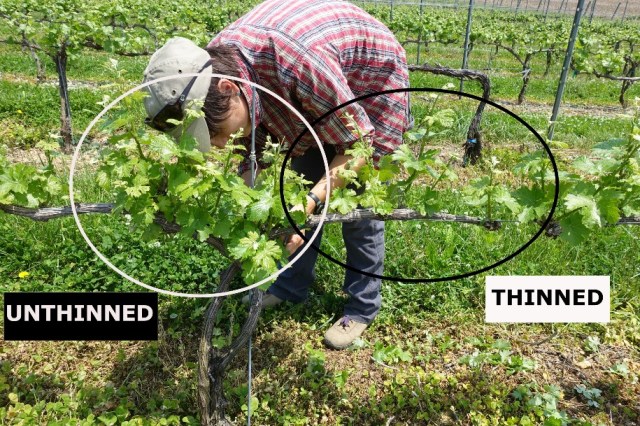[Information based on DipWSET D1 material]
As much as we like to hear the term “hands-off” vineyard management and winemaking, let’s face it, that will never be 100% true. Vines have a natural tendancy to sprawl and crawl—they don’t know they’re supposed to make balanced wine. And, so, we study canopy management.

Main Goals of Canopy Management:
- Maximize the effectiveness of light interception by the vine canopy—i.e. make sure that the right part of the vine is receiving the right amount of sunlight at the right time during the growing season.
- Reduce shading within the canopy—this is a play on the first point above, but basically, you have to make sure that during the ripening season, the grapes are exposed to enough sunlight to help them ripen. Of course, in an extremely warm and sunny region, you may want to prune in such a way that there is some shading.

- Ensure the microclimate for the grapes is as uniform as possible—this will help with even ripening across all vines.
- Promote balance between the vegetative and reproductive functions of the vine—this refers to controlling the canopy growth once berries enter veraison. Too much energy going to the green material will mean that part of the vine will continue to develop while the berries suffer. It also means that those latent buds—those buds that will create shoots and leaves and inflorescences next season, will not receive enough nutrients, so your next year’s harvest is affected as well.
- Arrange vine canopy to ease mechanization or manual labor—there are certain trellising systems (not covered here) more suitable to mechanical harvesting than others and should be considered when establishing a vineyard
- Promote air circulation through the canopy—this will help prevent instances of pests and diseases
Under-crop, Over-crop, and Vine Balance:
Under-crop refers to a vine’s fruit yield being too low for the vigor of the vine. This means that the shoot growth continues to grow throughout the vine growth cycle. The green material then compete with the grapes for sugar, water, nutrients, etc.—and they’ll win! This means a dense, shady canopy, lower quality fruit, and less bud fruitfulness—i.e. your next year’s harvest will be effected as well. And then the year after that, and the year after that, and the year after that—this is called a vegetative cycle.
Over-crop refers to the fruit yield being too high compared to the vigor of the vine. It’s stealing sugars from the carbohydrates stored in the trunks, roots, and cordons, which is needed to fuel vine growth during dormancy and in early spring (for those early shoots and leaf formations). So, tons of fruit, yes. But you also have a weak vine-base. Bummer.
Spring and Summer Pruning:
Disbudding (removal of buds to manage vine balance as well as yields; NOTE: growers typically keep too many buds during winter pruning “just in case,” so this is their chance to assess and adjust the number of buds)
Shoot removal (the removal of shoots that are infertile or poorly positioned)

Shoot positioning (the positioning of shoots in a specific trellis system)

Pinching (trimming of shoot tips at inflorescence/flowering to improve fruit set)

Shoot trimming (trimming the shoots to reduce canopy growth and thickness, reducing competition for nutrients between green material and fruit; also helps create better circulation thus lowering disease pressure)
Leaf removal (removing leaves to address shading or light needs of the fruit zone)

Green harvest (trimming off grape bunches pre-veraison (or just at the onset) so energy is focused on remaining fruit; helps reduce yields and concentrate flavors of remaining grapes)

How’d I do? Did I forget anything? Anything you want to add?
Thanks again for studying with me!
BriscoeBites officially accepts samples as well as conducts on-site and online interviews. Want to have your wine, winery or tasting room featured? Please visit the Sample Policy page where you can contact me directly. Cheers!
**Please note: all reviews and opinions are my own and are not associated with any of my places of business. I will always state when a wine has been sent as a sample for review. Sending samples for review on my personal website in no way guarantees coverage in any other media outlet I may be currently associated with.**



Wow! Excellent material. Currently studying for the D1 exam and your posts really help.
Thanks!